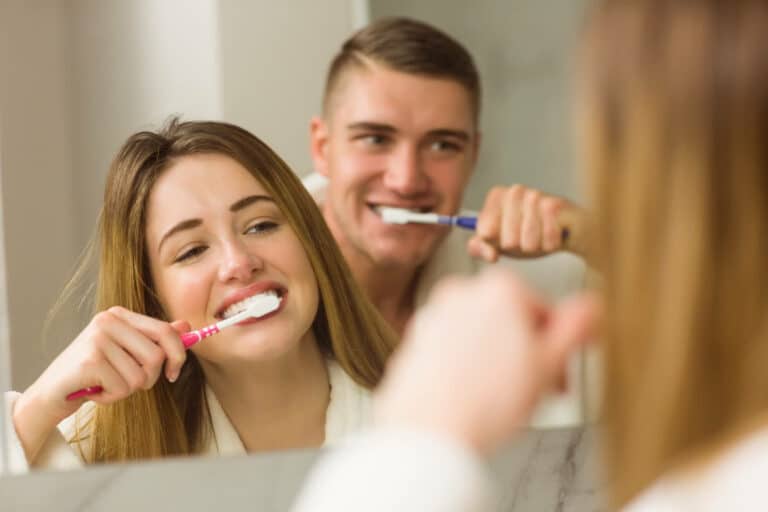
If you’ve ever stood in the toothbrush aisle at a Phoenix or Chandler store, you’ve likely felt overwhelmed. Electric toothbrushes promise advanced technology. Manual brushes offer simplicity and tradition. Both claim to give you a cleaner, healthier smile but which one is actually better for your teeth and gums?
At Dentique by Dr. B, serving patients from Phoenix, Chandler, and Ahwatukee, AZ, we help patients choose the right oral care tools every day. Whether you’re upgrading to an electric toothbrush or sticking with a reliable manual brush, the decision impacts your brushing effectiveness, gum health, and long-term dental care needs.
This guide explores the pros, cons, and science behind both options, so you can pick the best toothbrush for your lifestyle and smile.
Why Your Toothbrush Choice Matters
Brushing is the foundation of oral health, and your toothbrush is your primary tool in preventing cavities, gum disease, and bad breath. The right brush for you depends on your dental needs, lifestyle, and comfort level.
For patients in bustling Phoenix or the quieter neighborhoods of Chandler and Ahwatukee, the best toothbrush is the one you’ll use properly and consistently.
Manual Toothbrushes: Reliable, Affordable & Accessible
Benefits of manual toothbrushes:
- Budget-friendly – Often just a few dollars
- Easy to find – Available in every drugstore, grocery store, and even gas station
- No batteries or charging required – Perfect for travel
- Many options – Sizes, bristle firmness, and handle designs to suit your comfort
Potential drawbacks:
- Requires proper technique — brushing for the full two minutes with the correct motion
- Easy to apply too much pressure, which can damage gums
- No built-in timers or reminders
Best for: People who already have excellent brushing habits and don’t mind the extra effort.
Electric Toothbrushes: Advanced Cleaning & Ease of Use
Benefits of electric toothbrushes:
- Superior plaque removal – Studies show they reduce plaque and gingivitis more effectively than manual brushes
- Built-in timers – Ensure you brush for the full recommended two minutes
- Pressure sensors – Protect gums from over brushing
- Multiple modes – Options for whitening, sensitive teeth, or gum care
- Great for limited dexterity – Less manual effort needed
Potential drawbacks:
- Higher upfront cost (typically $20–$200)
- Replacement brush heads add ongoing expense
- Requires charging or batteries
Best for: People who want a more effortless and effective clean, or those with gum sensitivity or mobility challenges.
Electric vs. Manual: Side-by-Side
| Feature | Electric Toothbrush | Manual Toothbrush |
| Plaque Removal | Excellent | Good (if used properly) |
| Ease of Use | High | Moderate |
| Upfront Cost | Higher | Low |
| Ongoing Cost | Replacement heads | New brush every 3–4 months |
| Special Features | Timers, sensors, modes | None |
The Science Behind Cleaning Power
A 2014 Journal of Clinical Dentistry study found electric toothbrushes removed significantly more plaque than manual brushes over a three-month period. Many dentists, including Dr. BB, recommend them for patients who need help with consistent technique.
Cost Comparison: Which Gives More Value?
- Manual: $2–$8 upfront, replaced every 3–4 months
- Electric: $20–$200 upfront, brush heads $5–$10 every 3–6 months
- Long-term value: Electric brushes may help prevent costly dental treatments by improving cleaning effectiveness
Ease of Use: Matching Your Brushing Style
If you struggle to brush for two full minutes or tend to brush too hard, an electric toothbrush with a timer and pressure sensor can be a game-changer.
If you travel frequently or prefer simplicity, a manual toothbrush might be the better fit.
Gum Health Considerations
Over Brushing can cause gum recession, a problem we often see at our Phoenix dental office. Electric toothbrushes with sensitive modes help protect gums.
Manual toothbrush users must focus on gentle circular motions rather than aggressive scrubbing.
Proper Brushing Techniques (No Matter Your Brush)
- Brush for two minutes, twice daily
- Use gentle pressure to avoid gum irritation
- Replace your brush/brush head every 3–4 months (or sooner if bristles fray)
- Pair brushing with daily flossing and regular professional cleanings
Dr. B’s Top Recommendations
- Electric: Sonicare or Oral-B models with timers and pressure sensors
- Manual: Soft-bristle brush from a reputable brand with a comfortable handle
- Pro Tip: Ask us at your next visit in Phoenix, Chandler, or Ahwatukee for a toothbrush recommendation based on your gum health and enamel needs.
Making the Best Choice for Your Smile
There’s no one-size-fits-all answer. The best toothbrush is the one you’ll use correctly and consistently. Electric brushes may offer better cleaning power and ease of use, while manual brushes remain affordable and reliable.
Get Personalized Toothbrush Advice
Your toothbrush is just one part of your oral health routine but it’s a big one. At Dentique by Dr. B, we help patients in Phoenix, Chandler, and Ahwatukee choose the tools and techniques that keep their smiles healthy for life.
Call us today at 480-598-5900 or visit www.dentiqueaz.com to schedule your next dental cleaning and personalized toothbrush consultation.


